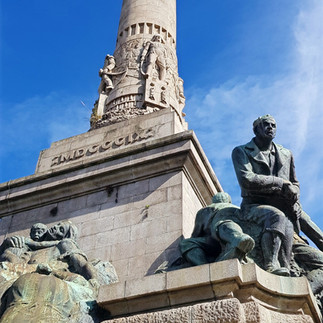Boavista Monument - almost 50 years to be built
- Carla Fernandes
- Mar 16, 2022
- 3 min read
Actually, the famous Boavista roundabout, nicknamed by all portuenses, is the Mousinho de Albuquerque square. But... a secret... shh... almost nobody in the city knows it!!!

This is the roundabout where you will find the Monument to the Heroes of the Peninsular Wars, the so-called monument of Rotunda da Boavista.
And, no, the Lion and the Eagle have nothing to do with football, football provocations aside, let's get back to the famous Monument. It is perhaps the most famous monument in the city of Porto. If it is true that monuments are not measured in inches, just like people, the 45 meters of height of this one make it an imposing and unavoidable presence in the city's profile. I dare say it rivals the Torre dos Clérigos, the City Hall building and even the Casa da Música, so futuristic and right next door.
Work of Architect José Marques da Silva (1869-1947) and Sculptor António Alves de Sousa (1884-1922) besides being the largest monument in the city, it was the one that took the longest to be built, almost 50 years. Yes, almost half a century between the project (1908) and the inauguration (1952). It took so long to build that, unfortunately, its creators did not see it finished in their lifetimes.
The ostentatious monumentality of "O povo e Tropa", as it was called by its creators, had everything to be a unique monument in the city of Porto. It is worth remembering that, at the time, Marques da Silva was already an outstanding figure and was considered by many to be the "Architect of the City". It should be noted that he designed the National Theater of São João in Porto and the famous São Bento station.
His Sculptor, almost an illustrious unknown, would have been a protégé of Marques da Silva's wife and perhaps, for this fact, in addition to his enormous talent, chosen to sculpt the Monument.
The future vision should be praised, especially the effort to adapt it to its intended location, a roundabout, which at the time was already a radial confluence of seven roads.
Starting by considering an arch of triumph, so fashionable at the time, they innovated and opted for a lion and an eagle symbolizing the strength and determination of the Luso-British army to subdue the Napoleonic eagle. The remaining sculptural group features the Nation in a woman - Victoria - guiding the uprising of the people, dramatic scenes of the invasion of Porto by General Soult's army, and an iconic painting of the Ponte das Barcas tragedy, and finally, immortalizes the military leaders in the figures of four of their commanders.
Marques da Silva, in his characteristic genius, erected the central monument, with the visual weight at the base and the delicate silhouette of the column over the city. In this way, he safeguarded the values of multiple perspectives and established a new type of monument.
The work suffered several setbacks, the untimely death of its sculptor António Alves de Sousa, controversies with the inspectors and the usual lack of money.
The construction goes into an unsustainable stage, times have changed and a new artistic conception has emerged, the project is considered dated and incongruous. Weeds and vegetation grows in such a way around the construction that the image of degradation is a reason for mockery in the city of Porto. It was quickly nicknamed the "candlestick" of Boavista. In 1933, proposals appeared in the City Hall for its demolition. Once again, the press had a preponderant role and it is to the press that we owe the existence of this monument, defending and expressing the continuity of the work. Parallel to all this, there was also a monumental slippage in the budget for the construction of this magnificent piece of sculpture. Some things don't change in Portugal.

Henrique Moreira would be responsible for the sculptures created by Alves de Sousa at the foot, and Sousa Caldas for the Eagle-Lion group. This is how the work continued.
In 1947, another harsh setback, the death of Marques da Silva, who never got to see the end of his work.
In 1952, finally, the monument was finished and its inauguration on May 27 was attended by the President of the Republic Craveiro Lopes.
The city of Porto had its Monument to the Heroes of the Peninsular Wars and with time gained its ex-libris.
A work esthetically out of its time, but without a doubt, settled well in the place for which it was intended.
Now almost 70 years old, it is admired and treasured by the locals, and is one of the most beloved monuments of the city of Porto.










Comments